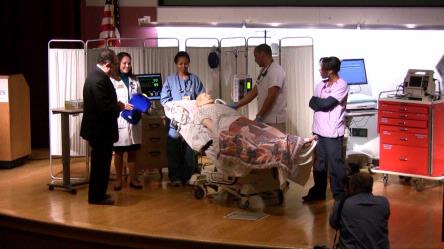Pharmacy Participates in Interprofessional Critical Care Simulation
UMB President Jay A.Perman, MD, provides keynote address at the exercise

By Ed Fishel
April 4, 2011
The Universities at Shady Grove’s Committee on Collaboration, Interprofessional and Interdisciplinary Education Strategies (CIPES) conducted its first “Interprofessional Critical Care Simulation” seminar on April 1.
The event involved faculty and students from the University of Maryland Schools of Nursing and Pharmacy and the Salisbury University Respiratory Therapy Program. Ashleigh Vines, a fourth-year student pharmacist, represented the School of Pharmacy on the critical care team.
Jay A. Perman, MD, president of the University of Maryland (UM), participated in a demonstration of interdisciplinary care for a critical care patient and gave a talk about interdisciplinary education, one of his passions.
The audience, consisting of faculty, students, and friends of the Universities at Shady Grove (USG), was welcomed by Stewart Edelstein, PhD, the USG executive director.
Heather Congdon, PharmD, CACP, CDE, assistant dean of the University of Maryland School of Pharmacy and co-chair of CIPES, introduced the program and Perman.
CIPES was created to promote excellence in education through interprofessional and interdisciplinary collaboration and scholarship, and to assure that the Universities at Shady Grove students “are exposed to the knowledge and the skills to engage collaboratively with other disciplines and professions to provide high quality service to the populations they serve.”
The program began with a simulation of a critical care response to a 19-year-old “patient” who had just undergone surgery to repair a shattered ankle after a rush hour accident on the Washington Beltway. The “patient” had a blood alcohol level of 0.168 percent when admitted to the hospital. A faculty member and two students from the School of Nursing, Vines from the School of Pharmacy, and a student from the Salisbury University Respiratory Therapy Program participated in the exercise with Perman.
Afterwards, Perman presented a talk on the history of interdisciplinary health care, which is typical for critical care, but not as common in primary care and chronic care settings. He presented the arguments why interdisciplinary care makes sense, but cautioned that the scientific evidence to support the arguments for interdisciplinary care is lacking, so far.
Perman has created an Interdisciplinary Education Task Force to study opportunities for curriculum changes at UM, and is leading the way for interdisciplinary education with his “President’s Clinic.” Each Tuesday afternoon, Perman, a pediatric gastroenterologist, continues to see patients at the University of Maryland Medical Center along with his nurse practitioner partner and students from each of the six professional schools.
